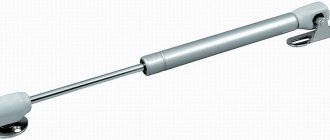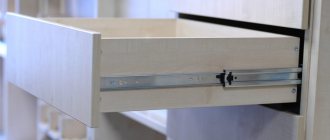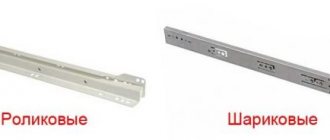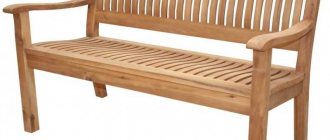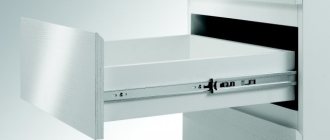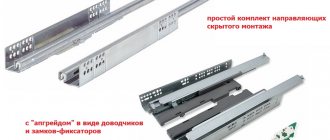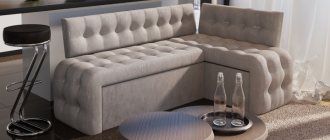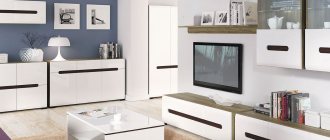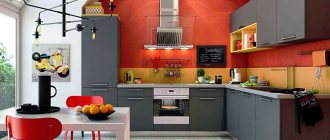Roller
They have the simplest design and fairly low cost. Another characteristic feature is the durable epoxy coating (can be any color).
Disadvantages - noise when extending/retracting, low reliability, relatively short service life if installed incorrectly.
With door closer
Guides for drawers with closers have a similar structure to the previous version. The closer ensures that the drawer is picked up in a certain position and smoothly closes automatically.
Advantages: smooth and quiet operation, reliability and ease of use, ability to withstand significant loads.
Ball devices
These devices are installed when it is necessary to withstand a significant load and to ensure that the extension is complete. Such systems are capable of “holding” up to 60 kg.
They can be mounted in any plane. There are enough modifications of such designs. They vary in size and configuration.
Advantages:
- Quiet when moving.
- Long service life.
- Adjustments in both directions.
- Working under load.
- Maximum extension.
Full extension
Such fittings are most in demand by modern furniture manufacturers. The basis of the design is a ball bearing.
Advantages - they allow you to open the drawer smoothly and completely, the model range is quite wide. The downside is the need to be extremely careful during installation so as not to damage the parts.
Metaboxes
Relatively recently, advanced modifications were created on the basis of roller ball guides. The development of fittings has led to the emergence of improved versions. These are sidewalls that move on runners.
The facade is installed on the fastenings. The metalbox can be easily removed and reinstalled. They are available in partial extension (3/4) and full extension. Length 270 – 550 mm.
Load up to 25 kg (inverse dependence on length). The height of the sidewalls is from 54 mm to 150 mm. To make furniture silent, it is recommended to install closers and dampers on it.
Surface mounting
Installing such guides is the most difficult. The process takes a long time and requires significant effort.
Pros: ease of use, high reliability and quality, smooth running and quiet operation.
Photo of drawer guides
Read here - Low and high pass filter: making frequency filters and how to create high-end circuitry (95 photos + video)
Reverse acting
In this case, you need to lightly press the front of the drawer with your hand so that it begins to open. No handles or recesses are needed, which only adds to the attractiveness of the furniture.
The downside is that it takes significant effort to push the drawer. In addition, it extends too sharply.
Which retractable mechanism to choose
When choosing a mechanism, you need to consider three things: budget, expected load, design. The choice depends only on the consumer. If you want furniture without handles, a reverse ball system is suitable. If you want to get a super economy, you should choose standard roller guides.
Scope of application of furniture nails, varieties in shape, size
If significant loads are planned, ball guides or hidden installation options are recommended (here it is also worth considering how much the bottom can withstand). Those who have an unlimited budget can choose tandem boxes. It is also worth considering the safety and depth of the structure. As already mentioned, reverse action guides are not recommended for children. And the depth determines how far the fittings can extend the drawer. If you take deep furniture, for example, 900 mm, it is better to give preference to full extension systems and tandem boxes. In terms of product quality, it is better to focus on the market leaders - Boyard, Blum, TBM, Hettich, Braun or Raumplus.
Reverse ball system suitable for furniture without handles
Standard roller guides are worth choosing for super-economy
For significant loads, ball guides are recommended
If the budget is not limited, choose tandem boxes
Tandemboxes and metaboxes
These are new items. You can find them in stores quite recently. The main differences are that the guide is located inside the side metal wall, there is a closer and dampers.
Advantages - original design solution, aesthetics, ability to withstand heavy loads, ease of use, durability. Disadvantages - the use of special marking devices is required.
Selection rules
What to consider when choosing drawer slides? You need to pay attention to the following factors:
- The parameters of the guides must correspond to the parameters of the furniture in which they will be installed.
- Before going to the checkout, check the thickness of the metal and the serviceability of the product as a whole.
- Evaluate the appearance of the fittings. Scratches, chips and other defects must be absent.
- Be sure to check the package before purchasing.
- Read the installation instructions to make sure you can do all the operations yourself.
Types of guides for retractable structures
Any retractable mechanism for cabinet furniture is based on the operation of ball or roller guides. Ball elements are also called “telescopic”, in common parlance “telescopes” due to the peculiarities of the inner part of the runners being pulled out from the body from the outside. They are somewhat more expensive in cost than roller components.
The sizes of ball guides can be 25, 30, 35, 40, 45, 50 and 55 cm. Roller types of guides are the cheapest and simplest extension mechanism - a pair of plastic rollers slide along the runners, and when lifting to a small diagonal you can easily reach from each other. Roller sizes are 25, 30, 35, 40, 45, 50 and 55 cm. Each of both types has many advantages and varieties.
Retractable systems based on roller guides
For example, specialized retractable systems work on roller types of guides, or rather, metaboxes, which are metal sidewalls for drawers that have different heights. Metaboxes are sometimes called samboxes or metaloboxes. They can be equipped with transverse and longitudinal rails, and can also be expanded using perforated and blind inserts, and also supplemented with closers. Most pull-out baskets and shelves for wall-mounted wardrobes and wardrobes also roll out thanks to a roller guide built into the hanging frame.
Retractable systems based on telescopic guides
There are also quite a few types of telescopic retractable systems. Ball guides for drawers are distinguished by the installation method. If they are mortise and overhead, and also with a hidden type of installation, then the retractable type mechanism is “hidden” under the bottom of the storage box. The system for moving roller type guides does not make it possible to build a closer inside the mechanism - it can be installed as a separate capsule and “slows down” the movement of the drawer. But ball-type guides with a built-in closer are presented in the form of a single mechanism. Also, all roll-out types of baskets, cargo and other mesh storage systems with closers that ensure “retraction” of the mechanism will “work” thanks to ball guides.
Separately, we should highlight the so-called tandem boxes - these are specialized retractable types of systems with double-walled metal sides, inside of which there is a ball guide with a special modification that ensures silent and smooth closing on the closer. Tandem boxes are designed for a high degree of load lifting, and there are also models with a dynamic load of up to 80 kg. Let's compare - the load-bearing capacity of metaboxes on guides with rollers is only up to 30 kg.
Roller guides for drawers, sizes and nuances to choose from
The dimensions of roller guides for drawers and special storage systems are selected according to the depth of the niche in which you plan to install them. In this case, the assembled box must be at least 1-2 cm deep. For example, in a cabinet with sidewalls, the depth of which is 42 cm, guides with a length of 40 cm are selected. The size range of roller types of guides for drawers is presented in sizes from 25 to 55 cm (extremely rarely the figure is larger, up to 60, 65 and 70 cm) in 5 cm increments. There are holes for installation along the total length of the rails. The distance between them follows the popular rule for cabinet furniture, and it is called “system 32”. Its essence lies in the multiplicity of the distance for setting the numbers 16 and 32 - 128, 96, 64, etc. When assembling drawers on roller guides, one part of the rails in the form of an angle is attached to the drawer, with a grip on the bottom, and the second to the inside of the side of the wardrobe .
When choosing roller guide types for drawer types, it is worth considering not just the length of the rails, but also the quality characteristics of the mechanism itself:
- Metal thickness - the main part of breakdowns occurs due to the low rigidity of the rails. Drawers fall out of the grooves, thereby bending them with their mass. To prevent this from happening, when choosing, you should pay attention to the metal and its thickness. Ideally, for shallow (up to 35 cm) and low (up to 25 cm along the facade) types of drawers, choose guides on rollers with a thickness of 0.1 cm. For the rest, the figure is from 0.12 to 0.15 cm.
- Load-bearing capacity - roller types of guides for drawers are the most inexpensive mechanism of all that are on the market. Cheapness is also determined by the obviously low requirements for weight loads, quality of care, etc. The dynamic load on the roller-type mechanism should not be more than 10-20 kg, taking into account the weight of the box (depending on the dimensions, a retractable drawer can weigh from 3 to 7 kg).
If you are planning to make retractable drawers in a dressing room or closet with a high load and quite large in size, you should choose the equipment option among ball retractable systems. The fact is that they will last much longer and will not irritate with sharp movement, noise and squeaking when moving.
Articulated guides
If everything is clear with roller guides for drawers, then with ball mechanisms things are somewhat different.
In terms of quality characteristics, they are much better - ball devices are more stable, durable, and also provide smooth movement for drawers and are almost silent. In addition, they are more expensive. There is also great news, which is that the calculation of the dimensions of the box for retractable drawers for ball and roller guides is completely the same.
The size of the gap between the sidewalls and the box frame for all types is from 1.25 to 1.3 cm. It turns out that you can always change the roller guides to ball (telescopic) ones if the quality of the former does not suit you for some reason. An exception may be mortise types of guides and hidden installation methods - the technological dimensions of the gaps between the sidewalls and the box frame are calculated differently for them. In terms of size, retractable drawers with a hidden installation method are larger in width, and the gaps between the box and the sides are smaller (internal dimensions are 4.9 cm and 9 cm when calculated).
At the same time, there is a difference in the installation of ball guides for retractable systems - if the roller guides “cling” under the bottom, and the ball guides along the middle of the sidewall. The dimensions of ball guides for drawer types according to the installation holes also follow the “System 32” rules. When choosing ball-type guides for a retractable drawer, you should pay attention to the thickness of the metal, the size and load-bearing capacity of the mechanism.
Telescopic thin mechanisms are more designed for the installation of pull-out shelves with medium and low loads. Wider in size and “powerful” are suitable for deep drawers in a chest of drawers with a width of up to 90 cm. The design of a retractable drawer and its contents from the inside also vary in functionality and size.
Installation of roller type guides
Before you begin installing the fittings, you must carefully read all the tips for removing and installing the guides. They can be found on the Internet. It is enough to visit specialized sites.
Let's look at the step-by-step assembly of drawer guides:
We attach two guides to the bottom of the drawer. The elements must be positioned so that the roller is located at the back wall, and the other end rests against the facade.
We fix the strip using self-tapping screws, placing them so that their heads are below the surface of the strip.
We attach the remaining pair of guides to the cabinet body. We pre-mark the attachment points with a pencil.
Which drawer guides are best to choose depends on your wishes, the design features of the furniture and your financial capabilities.
If you are choosing guides to replace outdated or broken elements, then it is best to choose similar models.
Whatever variety you need, consider products only from trusted manufacturers, since a well-known brand serves as a guarantee of quality.
Roller mechanisms
They are much cheaper. But they do not extend completely. There is a clanging sound when opening, so it is recommended to use rubberized rollers.
For durable operation, the thickness of the runners must be at least 1.2 mm. Their length is 250 mm – 750 mm (in increments of 50 mm).
Withstand load 20 kg. When overloaded, the parts become deformed and the device fails. Disadvantages include difficulties in accurately installing the facade.
